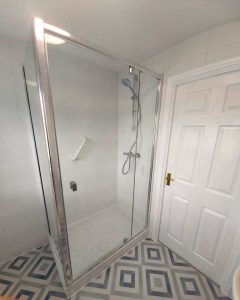
There’s nothing better than a well-appointed bathroom for making us feel refreshed, clean, and ready for action. And with many homeowners aspiring to the luxe standards enjoyed in modern hotels, domestic bathrooms are facing their biggest overhaul in years.
Deciding where to start with a facelift can be overwhelming. Aside from the kitchen, these small rooms are perhaps the most complex in terms of plumbing, electrics, and layout so it’s no wonder many folks get confused with the practicalities and sheer choice of tiles, showers, taps, and accessories. The best way to start is to make a list of your top requirements and, first and foremost, decide whether you prefer a bathroom or a wet room.
To bathe or shower?
When deciding between bathrooms and wet rooms, several factors need to be considered, including space, building practicalities, running costs, cleaning, maintenance, and user needs. Below we explore each of these aspects to help you make an informed decision:
-
Space
Consider the available space and layout of your property. Bathrooms typically require more space than wet rooms because they have separate shower enclosures, bathtubs, and other fixtures. Wet rooms, on the other hand, have an open design with a fully waterproofed floor that allows the entire area to be used for showering. If space is limited, a wet room may be a more efficient use of the available area.
-
Practicalities
Assess the structural aspects of your building. Installing a wet room requires proper waterproofing, sloping the floor for drainage, and installing a tanking system to prevent leaks. If your building’s structure is not suitable for these modifications, it may be more feasible to opt for a traditional bathroom or an extra-large traditional shower.
-
Running costs
With energy bills top-of-mind, consider the long-term costs associated with bathrooms and wet rooms. Wet rooms can be more expensive to install initially due to the additional waterproofing measures required. However, wet rooms may have lower maintenance costs in the long run as there are fewer fixtures and potential points of failure. Bathrooms, with their separate shower enclosures and baths, may have higher water consumption and utility costs.
-
Cleaning
Evaluate the ease of cleaning and maintenance for bathrooms and wet rooms. Wet rooms generally have fewer surfaces and fixtures to clean, making them easier to maintain. The absence of shower enclosures also eliminates the need for regular cleaning of glass doors or curtains. However, proper cleaning and ventilation are crucial in wet rooms to prevent mould and mildew growth. Bathrooms may require more frequent cleaning due to the additional surfaces and fixtures. While wet rooms benefit from a regular spray with cleaning products, a refreshing hose down and squeegee dry.
-
Maintenance
Bathrooms have individual fixtures like baths and shower enclosures, which may require repairs or replacements over time. Wet rooms have a simpler design, but if any issues arise with the waterproofing or drainage system, it can be more challenging and costly to fix. Tiled walls should be frequently checked for greying grout in either setting. If you’re undergoing a refurb, consider replacing tiles with large water-proof panels to reduce cleaning and maintenance time.
-
User needs
what are your specific needs and family preferences. Some people like the convenience of a separate bath or shower enclosure offered by a bathroom. Others may prefer the open and accessible design of a wet room, which is particularly beneficial for individuals with mobility challenges or disabilities. If your weary bones love a long hot soak at the end of the day – wine and candles optional – you’ll want to keep the tub. If a powerful hot/cold shower is more your style and you really can’t fathom lying in bathwater, check out the latest invigorating air- and steam-showers.
Ultimately, the decision between a bathroom and a wet room depends on your space, budget, maintenance capabilities, familial needs, and your preferences. It may be helpful to consult with professionals such as architects or interior designers to assess your space and help make an informed choice. Whatever you choose you’ll need a competent plumber to deliver the plan.

